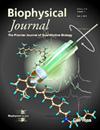Multiplexed stamp-transfer AFM deposition improves resolution of protein-DNA conformational states.
IF 3.1
3区 生物学
Q2 BIOPHYSICS
引用次数: 0
Abstract
Single-molecule analysis of atomic force microscopy (AFM) images is a powerful tool for characterizing the structural and conformational properties of proteins, DNA, and protein-DNA complexes, as well as nonbiological molecules, such as polymers. Since the invention of AFM in 1986, significant technical advances have been made, including faster scan speeds and automated image collection and analysis. Deposition methods, however, remain essentially unchanged. Typically, several microliters of the sample are dropped onto a mica surface (unmodified or modified), allowed to spread, rinsed with water, and dried. Although this method is generally effective, it remains a chokepoint to efficiently collecting AFM data. To alleviate this bottleneck, we invented a stamp-transfer method to deposit multiple samples simultaneously onto a mica surface for imaging. We fabricate arrays of microwells in a silicon chip, fill them with samples, and bring the silicon chip into soft contact with mica to transfer the sample. This method not only allows the simultaneous deposition of multiple different protein and DNA samples, but it also expands the buffer conditions for deposition of DNA and protein-DNA complexes onto an unmodified the mica surface into the physiological-salt range. Furthermore, our data indicate that the stamp-transfer deposition significantly improves the ability to resolve different conformational states of protein-DNA complexes from one another. Finally, this method can be readily automated and has the potential revolutionize AFM imaging both by improving resolution and making it "high throughput".多路印迹转移AFM沉积提高了蛋白质- dna构象状态的分辨率。
原子力显微镜(AFM)图像的单分子分析是表征蛋白质、DNA、蛋白质-DNA复合物以及非生物分子(如聚合物)的结构和构象特性的强大工具。自1986年AFM发明以来,已经取得了重大的技术进步,包括更快的扫描速度和自动图像收集和分析。然而,沉积方法基本保持不变。通常,将几微升样品滴在云母表面(未修饰或修饰),使其扩散,用水冲洗并干燥。虽然这种方法通常是有效的,但它仍然是有效收集AFM数据的瓶颈。为了缓解这一瓶颈,我们发明了一种印章转移方法,将多个样品同时沉积到云母表面进行成像。我们在硅芯片中制造微孔阵列,填充样品,并使硅芯片与云母软接触以转移样品。这种方法不仅可以同时沉积多种不同的蛋白质和DNA样品,而且还扩大了在未经修饰的云母表面沉积DNA和蛋白质-DNA复合物的缓冲条件,使其进入生理盐范围。此外,我们的数据表明,印迹转移沉积显著提高了蛋白质- dna复合物相互之间不同构象状态的分辨能力。最后,该方法可以很容易地实现自动化,并且具有通过提高分辨率和使其“高通量”来彻底改变AFM成像的潜力。
本文章由计算机程序翻译,如有差异,请以英文原文为准。
求助全文
约1分钟内获得全文
求助全文
来源期刊

Biophysical journal
生物-生物物理
CiteScore
6.10
自引率
5.90%
发文量
3090
审稿时长
2 months
期刊介绍:
BJ publishes original articles, letters, and perspectives on important problems in modern biophysics. The papers should be written so as to be of interest to a broad community of biophysicists. BJ welcomes experimental studies that employ quantitative physical approaches for the study of biological systems, including or spanning scales from molecule to whole organism. Experimental studies of a purely descriptive or phenomenological nature, with no theoretical or mechanistic underpinning, are not appropriate for publication in BJ. Theoretical studies should offer new insights into the understanding ofexperimental results or suggest new experimentally testable hypotheses. Articles reporting significant methodological or technological advances, which have potential to open new areas of biophysical investigation, are also suitable for publication in BJ. Papers describing improvements in accuracy or speed of existing methods or extra detail within methods described previously are not suitable for BJ.
 求助内容:
求助内容: 应助结果提醒方式:
应助结果提醒方式:


